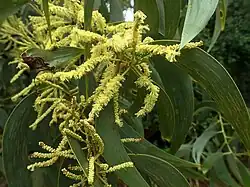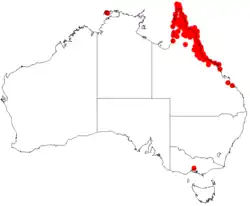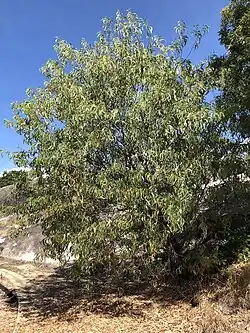Acacia crassicarpa
| Northern wattle | |
|---|---|

| |
| Near Yorkeys Knob | |
| Scientific classification | |
| Kingdom: | Plantae |
| Clade: | Tracheophytes |
| Clade: | Angiosperms |
| Clade: | Eudicots |
| Clade: | Rosids |
| Order: | Fabales |
| Family: | Fabaceae |
| Subfamily: | Caesalpinioideae |
| Clade: | Mimosoid clade |
| Genus: | Acacia |
| Species: | A. crassicarpa
|
| Binomial name | |
| Acacia crassicarpa | |

| |
| Occurrence data from AVH | |

Acacia crassicarpa, commonly known as thick-podded salwood, lancewood, northern golden wattle or northern wattle,[3] is a species of flowering plant in the family Fabaceae and is native to Queensland, Australia and New Guinea. It is a tree with lance-shaped, more or less sickle-shaped phyllodes, spikes of pale to light golden yellow flowers and flat, narrowly oblong to oblong, winged pods.
Description
Acacia crassicarpa is a tree that typically grows to a height of 6–25 m (20–82 ft) and has bark full of chinks, cracks, or crevices. Its branchlets are glabrous and slightly angular near the end. The phyllodes are lance-shaped to sickle-shaped, 80–270 mm (3.1–10.6 in) long, 10–45 mm (0.39–1.77 in) wide and leathery or thinly leathery, with many parallel veins, three veins more prominent than the rest. The flowers are pale yellow to light golden yellow and borne in spikes 30–70 mm (1.2–2.8 in) long. Flowering occurs between May and September, and the pods are flat, oblong to narrowly oblong, 40–120 mm (1.6–4.7 in) long, 20–45 mm (0.79–1.77 in) wide including the wing, more or less straight and sometimes spirally twisted. The seeds are oblong to egg-shaped, black, 5–6 mm (0.20–0.24 in) long with and aril 5–20 mm (0.20–0.79 in) long.[3][4][5]
Taxonomy
Acacia crassicarpa was first formally described by George Bentham in Hooker's London Journal of Botany from an unpublished manuscript by Allan Cunningham.[6][7] The specific epithet (crassicarpa) means 'thick fruit', referring to the thick woody pods.[3]
Distribution and habitat
Thick-podded salwood grows in woodlands and open forest in sandy or rocky soils in tropical Queensland, the islands of Torres Straight and as far south as Townsville with disjunct populations on Whitsunday Island and near Mackay. It also occurs in Irian Jaya and Papua New Guinea.[3]
Conservation status
Acacia crassicarpa is listed as "not threatened" under the Government of Queensland Nature Conservation Act 1992.[8]
References
- ^ Midgley, S. & Thomson, L. (2019). "Acacia crassicarpa". IUCN Red List of Threatened Species. 2019: e.T38366A67742318. doi:10.2305/IUCN.UK.2019-3.RLTS.T38366A67742318.en. Retrieved 6 June 2024.
- ^ "Acacia crassicarpa". Australian Plant Census. Retrieved 3 August 2025.
- ^ a b c d Kodela, Phillip G.; Maslin, Bruce R.; Tindale, Mary D. Kodela, Phillip G. (ed.). "Acacia crassicarpa". Flora of Australia. Australian Biological Resources Study, Department of Climate Change, Energy, the Environment and Water: Canberra. Retrieved 3 August 2025.
- ^ "Acacia crassicarpa". World Wide Wattle. Western Australian Herbarium. Retrieved 3 August 2025.
- ^ "Acacia crassicarpa". Australian Biological Resources Study. Retrieved 3 August 2025.
- ^ "Acacia crassicarpa". APNI. Retrieved 3 August 2025.
- ^ Bentham, George; Hooker, William Jackson (1842). "Notes on Mimoseae, with a synopsis of species". London Journal of Botany. 1: 379. Retrieved 3 August 2025.
- ^ "Taxon - Acacia crassicarpa". Queensland Government WildNet. Retrieved 3 August 2025.
